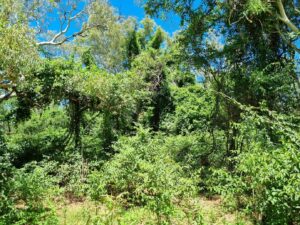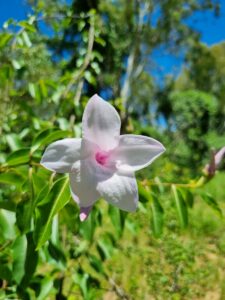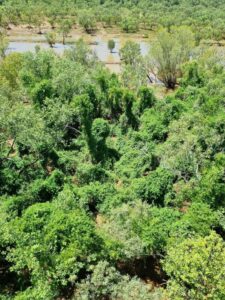Successful strides in rubber vine eradication: lessons from the East Kimberley region
Rubber vine (Cryptostegia grandiflora) is a declared pest in Western Australia, which can jeopardise pastoral production, agriculture, and biodiversity. The East Kimberley region has been particularly vulnerable to this threat.
Since 2009, a collaborative eradication initiative spearheaded by the Department of Primary Industries and Regional Development (DPIRD), the Department of Biodiversity Conservation and Attractions (DBCA), and the Kimberley Rangelands Biosecurity Association (KRBA)—under the newly amalgamated “Western Australia Rubber Vine Action Committee” (WARVAC)—has shown promising results. The initiative spans the southern end of Lake Argyle between the Ord and Bow Rivers, and Limestone Creek.
Annual aerial surveys, aligned with the peak of rubber vine flowering, cover the broader infestation area of 20,000 hectares. Linear searches along creeks and streams were conducted to maximize detection. Subsequent on-ground surveys employ a systematic transect pattern within 0.25-hectare grids, forming a comprehensive ‘grid network.’ Detected vines undergo meticulous recording of age categories, guiding the application of control methods.
The eradication campaign has made significant strides, removing over 72,000 plants. Various control methods have been employed, such as cutting and applying herbicide to the stump, manually removing smaller plants, using foliar application for densely populated areas, and subsequently burning them. The controlled burning not only removes the existing plants but also prepares the ground for the implementation of additional control measures. Rigorous aerial and on-ground surveillance has led to a notable reduction, plant density has decreased from approximately 40 plants/ha in 2014 to 9 plants/ha in 2021. By the end of 2021, 59% of the management area was eradicated, 26.4% was under monitoring, and 14.6% was under active control.
The decrease in the size of infested areas and the increase in monitoring and eradicated areas showcase the program’s progress towards eradication. Despite new infestations, the decreasing proportion of the management area in the control phase indicates effective control upon discovery.
Challenges persist, particularly in detecting all flowering vines during aerial surveys. To enhance the eradication campaign, efforts are underway to increase the detection rate of non-flowering vines. Strategies include expanding the area searched during aerial surveys, prolonging on-ground searches, and exploring remote sensing techniques for high-resolution image detection.
The initiative now encompasses the West Kimberley, where the team has initiated control measures over an equivalent-sized area. The endeavours in East Kimberley underscore the significance of collaborative approaches, methodical surveillance, and adaptive strategies in addressing rubber vine infestations. Sustained vigilance and ongoing innovation are crucial elements for ensuring enduring success in eradication efforts.
New resources for identifying rubber vine, including a glovebox guide/brochure titled “Priority Weeds of the Kimberley,” are currently in development. Additionally, rubber vine posters are being created for distribution to the pastoral community in the near future. Individuals are strongly encouraged to report any suspected Rubber vines to the Pest and Disease Information Service (PaDIS) through the MyPestGuide mobile app or via email at padis@dpird.wa.gov.au. Your vigilance and timely reporting contribute to effective management and control of Rubber vine in the region.


